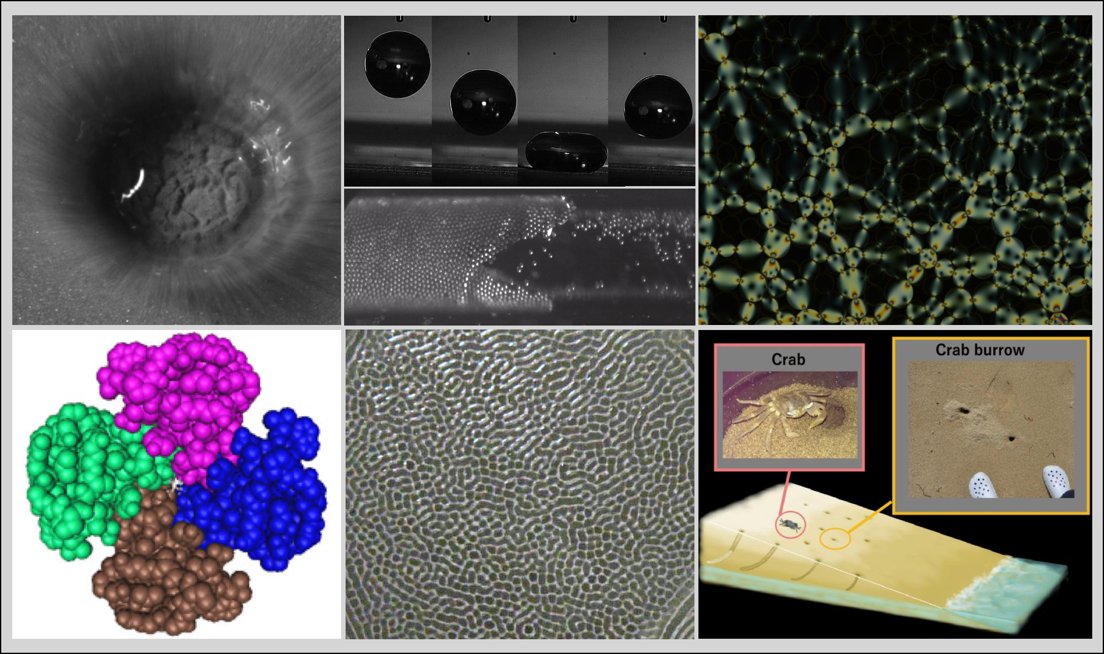Research Fields
Our department is conducting research on the following four major fields: "the universe", "the Earth and planets", "material", and "life". Each research group (eight groups at present) is responsible for pursuing everyday research activity as a fundamental unit. Here, we briefly explain the research areas covered by the groups of our department. Of course, the above four major fields are closely inter-related, and the research activity of each group often covers more than one field.
The universe
From the ancient times, man has always dreamt of understanding the endless universe. In our department, both the observational research on the basis of modern technology and the theoretical research on the basis of modern physics are conducted. In Theoretical Astrophysics Group (Nagamine Group), the study of the evolution of the universe beginning with the Big Bang and of numerous astrophysical phenomena including star formation, high energy plasmas, black holes and gravitational waves, is performed. In X-ray Astronomy Group (Matsumoto Group), X-ray observational study of supernova, active galactic nucleus, and black hole is performed by using satellites, together with the development of new techniques of X-ray spectroscopy. Infrared Astronomy Group (Sumi Group) mainly conducts researchs on exoplanets through gravitational microlensing surveys using ground-based telescopes such as MOA-II and PRIME, transit planet studies using data from space telescopes, and participation in future space telescope projects.
The Earth and planets
A better understanding of the Earth, which is the one and only planet we live, is indispensable for our future. It is also important to learn more about the other planets of our solar system. In our department, there are four experimental groups in this area. Planetary Science Group (Terada Group) studies the origin and the evolution of the solar system and Earth, mainly by using isotopic analyses. Earth and Planetary Materials Science Group (Sasaki Group) studies the formation and evolutionary processes of various planetary bodies using spacecraft and ground-based observations, numerical simulations, and experiments. Soft Matter Earth and Planetary Science Group (Katsuragi Group) experimentally investigates various phenomena from planetary surface terrain to biophysics from the multi-disciplinary point of view. Earth and Planetary Interior Material Science Group (Kondo Group) studies the nature of materials in the deeper parts of planets under high temperatures and pressures.
Material
The universe consists of a wide variety of materials. In order to understand the universe and Earth, it is essential to study the properties of materials forming the universe, particularly under extreme conditions. Theoretical Condensed-Matter Physics Group (Hatano Group) theoretically studies the nature of phase transitions exhibited by various materials, and the properties of earthquakes caused by a stick-slip frictional instability, mainly using computer simulations.
Life
Understanding of the origin and the evolution of life on the Earth is one of the fundamental unsolved problems in natural sciences and essential for prospecting our future. Soft Matter Earth and Planetary Science Group (Katsuragi Group) experimentally investigates the nature of life�fs raw materials in cosmic and terrestrial environments, their chemical evolution processes to biomolecules and their fossilization processes, with special attention to organic-inorganic interactions. The molecular evolution of photoreceptor proteins in relation to the environmental changes is also studied.
Research Groups
Theoretical Astrophysics Group (Nagamine Group)
Members
-
Daisuke Toyouchi
-
Luca Baiotti
-
Renyue Cen
-
Hiroyuki Hirashita
- Research area
-
It is widely believed that our Universe was born about 14 billion years ago with an infinite temperature and density, which is called the "Big Bang". As the Universe expanded and cooled down, various forms of matter were created, and the structures such as galaxies and stars emerged later. The main objective of our research group is to understand the various astrophysical processes that took place during the course of cosmic evolution, and clarify the formation and evolution of various astrophysical systems. We pursue a wide variety of research topics, including structure formation & cosmology, high energy astrophysics, jets, accretion disks, black holes, cosmic rays, galaxy clusters, dark matter, general relativity, gravitational wave astronomy, galaxy formation, star formation, proto-planetary disks, to name a few. In these topics, hydrodynamics, plasma physics and thermodynamics play important roles often case.
1) Structure Formation and Cosmology (large scale structure in the Universe, intergalactic medium, galaxy formation, clusters of galaxies, cosmic magnetic fields)
2) Formation of Astrophysical Bodies (planets, stars, galaxies, black holes)
3) Astrophysical plasma, magneto-hydrodynamics, solar physics
4) High Energy Emission from Astrophysical Objects
5) Gravitational Wave Astronomy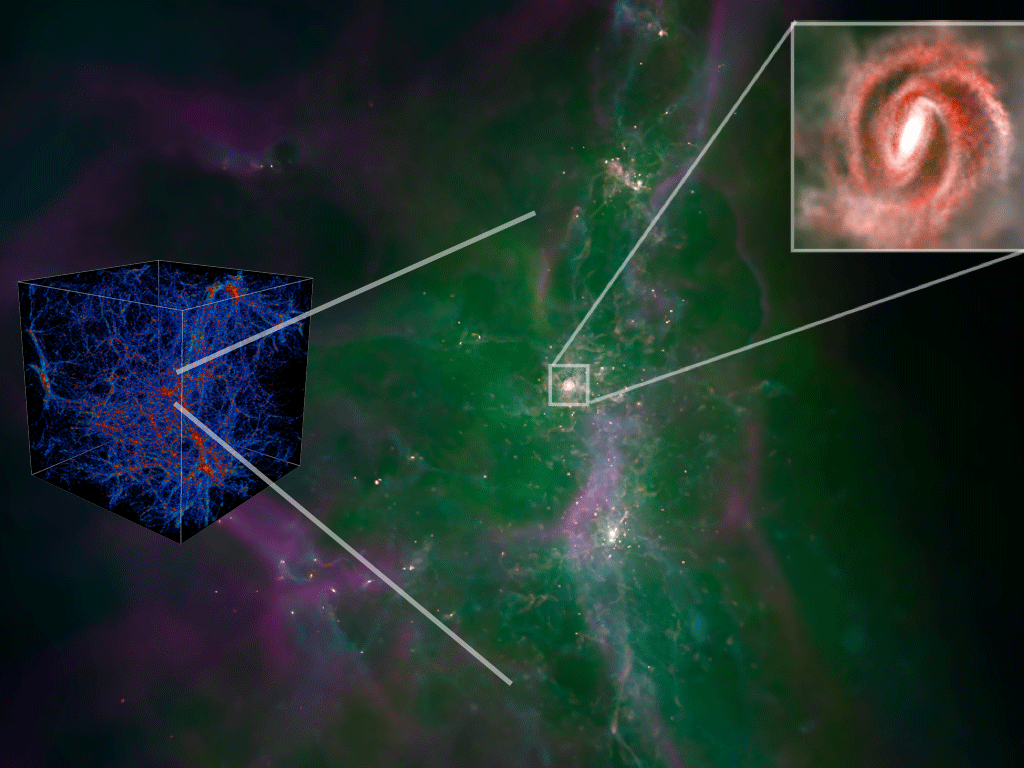
An example of zoom-in cosmological hydrodynamic simulations of galaxy formation within a large cosmological volume shown on the left hand side. On the right-hand-side of the panel, one can see a large spiral galaxy forming inside a filamentary gas structure (Thompson & Nagamine 2014). 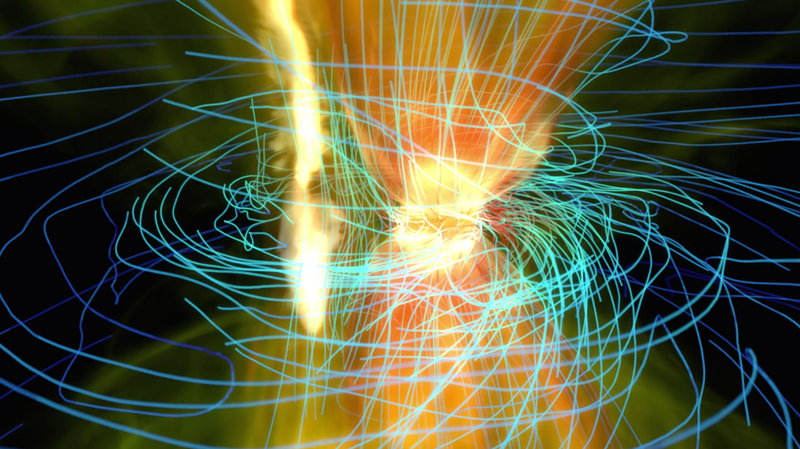
An example of the numerical simulation of an accreting, magnetized protostar. The protostar is producing a huge explosion called a protostellar flare (Takasao et al. 2019).
X-Ray Astronomy Group (Matsumoto Group)
Members
-
Hironori Matsumoto
-
Hirokazu Odaka
-
Taiki Kawamuro
- Research area
-
1)Observational study of optically thin hot plasma
2)Study of active galactic nuclei in X-ray observations
3)R&D of CCD cameras onboard X-ray satellites
4)Development of techniques of X-ray spectroscopy and X-ray polarimetryOur universe is dominated by optically thin hot plasma. For example, X-ray emitting hot gas occupies a substantial fraction of the luminous matter in the clusters of galaxies, which is still much less than that of the dark matter. Therefore, the distribution of the hot gas in our universe is practically a key clue to investigate the universe. In our galaxy, the hot gas generated in the supernova explosion collides with the interstellar matter, producing high energy cosmic rays. In the vicinity of a blackhole, high temperature gas is also generated, forming jet phenomena.
We are performing observation of high temperature gas using detectors onboard various satellites. We have developed X-ray CCD cameras for the Space Station that was launched in July, 2009. . We are now developing CCD cameras for ASTRO-H. Finally, we are developing new techniques of spectroscopy and polarimetry for the future application.
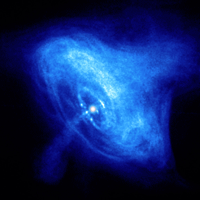
X-ray image of the Crab Nebula
(Courtesy of NASA/CXC/SAO/J. Hester et al.)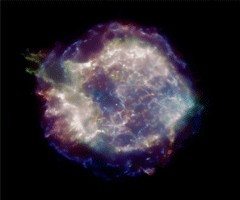
X-ray image of supernova remnant, CasA
(Courtesy of NASA/CXC/SAO)(1) Spectrophotometric observation of X-ray radiation from dilute high-temperature plasma
Thermal radiation from dilute high-temperature plasma such as that surrounding supernova remnants or galaxy cluster contains numerous emission lines from heavy atoms. We are studying physical states of such plasma to determine its atomic composition and state through spectrophotometric observations. We are investigating the circulation of matter and energy in the universe to understand the evolution of the universe.(2) Observation of active galaxies
Active galaxies are so bright that we can observe them despite of their far distance from the Earth. Observation of the large amount of produced energy and its temporal variation from the center of galaxies indicates the existence of giant black holes. In addition, the active galaxies are in such a far distance that the observation can also explore the time evolution of the early universe.(3) Observation by using X-ray satellites and preparation of future generation of satellites
The Suzaku satellite was launched in July 2005. The XIS (CCD camera) has been functioning properly to observe various targets. In July, 2009, the SSC (CCD camera) onboard the MAXI was launched by the Space Shuttle. We are responsible for X-ray CCD cameras (XIS and SSC) for both satellites. The CCDs employed(4) Research and development of new detector systems
Observation with superior detectors or techniques provides new findings. We are developing SD-CCD that can cover the energy range up to 100keV. By combining a super-mirror technology, we are planning to perform precise observation in hard X-ray region. We are also applying our technology in Earth observation satellite and in the laboratory experiments.(5) Research and development of new detector systems
Observation with superior detectors or techniques provides new findings. We are developing such superior radiation detectors for the future satellite projects. We are applying our superior detector technology to observations with balloon-born experiments and small scientific satellites, as well as to ground experiments.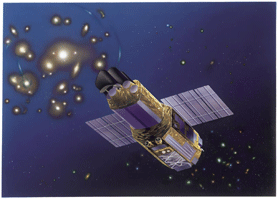
The Suzaku satellite launched in July 2005 (Courtesy of JAXA)
Theoretical Condensed Matter Physics Group (Hatano Group)
Members
-
Takahiro Hatano
-
Satoshi Yukawa
-
Kazushi Aoyama
-
Tomohiro Tanogami
- Research area
-
We study dynamics, statistics, and universality in nonequilibrium phenomena on the Earth and planets. Our approaches are theoretical, particularly statistical mechanics (either equilibrium and nonequilibrium), nonlinear dynamics, stochastic processes, and various computational methods.
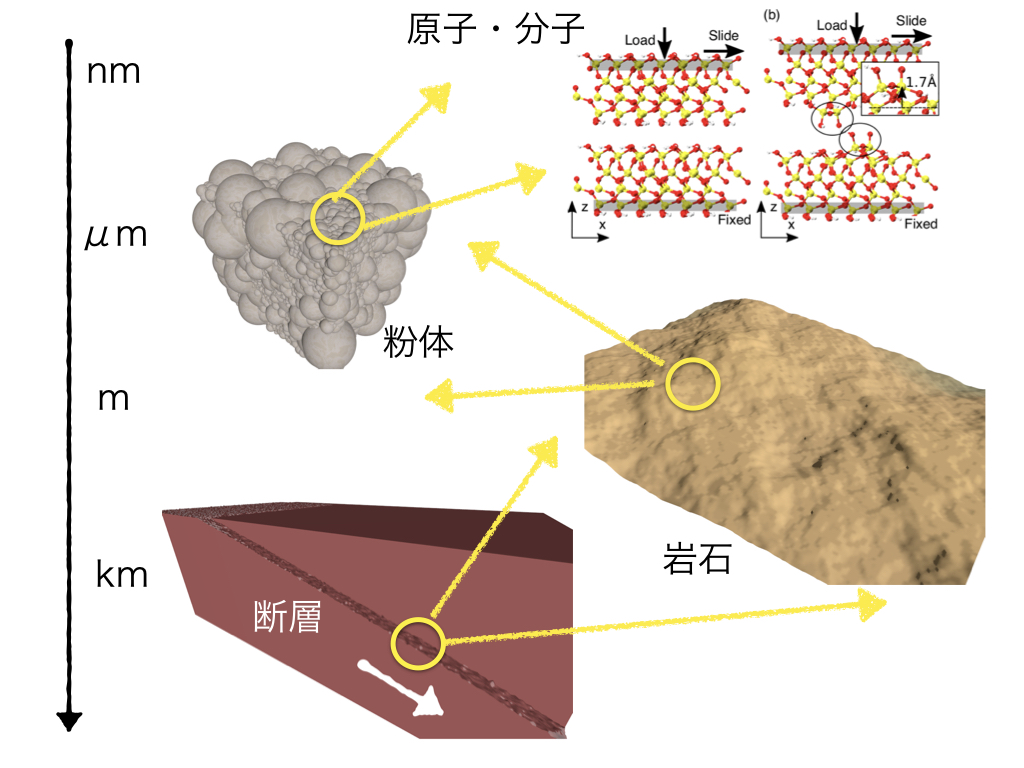
1)Physics of friction, fracture, and earthquakes: Time series analyses and statistical aspects of fracture and its potential applicability for earthquake forecast. Mechanical models for fracture and earthquakes. Physics of friction across the scales.
2)Dynamics of nonequilibrium phenomena in earth and planetary sciences: Heat conduction, spin flux, granular flow, etc. Phenomena where fluxes, diffusion, and phase transitions are interrelated. Such phenomena are investigated from the viewpoint of nonequilibrium statistical mechanics.
3)Statistical physics of frustrated spin systems: Ordering and defects in pyrochlore and triangular lattices.
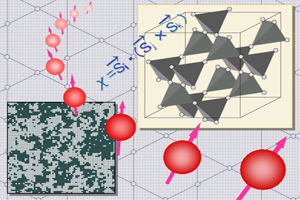
Planetary Science Group (Terada Group)
Members
-
Kentaro Terada
-
Chihiro Yamanaka
-
Shoichiro Yokota
-
Yosuke Kawai
-
Kohei Fukuda
- Research area
-
1)The origin and the formation of our solar system.
2)The evolution of the Earth and planets.
3)The magnetic properties of magnetic & weak magnetic planetary materials.
4)The studies on the laboratory/environmental electromagnetic phenomena.
5)Development of the technique/instrument for a new frontier of planetary science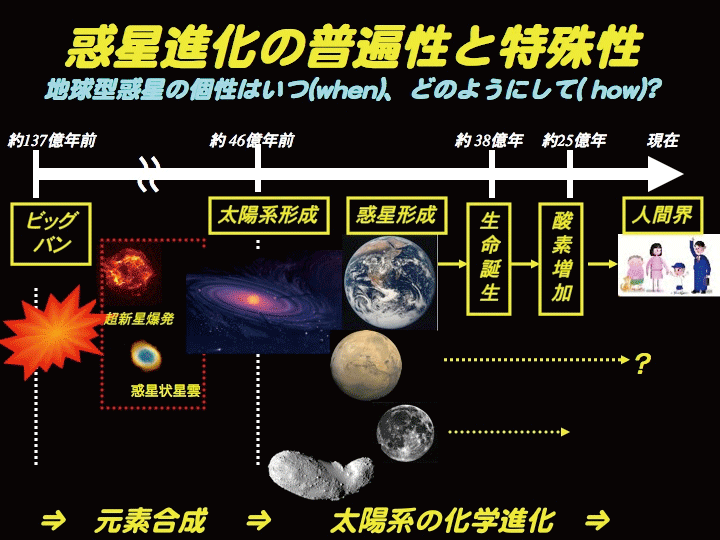
As far as we know, the planet Earth is a unique environment (especially for life). When and how were the Earth and other planets formed in the entire universe?
To decipher the history of the Earth, we focus on the origin, evolution and current environment of our solar system based on various experimental approaches. Mainly, we carry out precise isotopic analyses from hydrogen to uranium in Apollo samples, Martian meteorites, other various meteorites and circum-stellar dusts. We also conduct the studies on the organic matter in planetary materials. For better understanding of the magnetic structure of the primordial solar nebula, the magnetic properties of magnetic & weak magnetic planetary materials are examined. We are also investigating electron spin resonance and the relation between environmental electromagnetic field and natural phenomena.
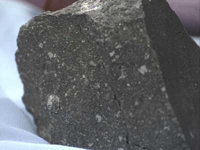
Earth and Planetary Interior Material Science Group (Kondo Group)
Members
-
Tadashi Kondo
-
Osamu Ohtaka
-
Masayuki Nishi
-
Tatsuhiro Sakaiya
- Research area
-
1)Phase transition and physical property change of minerals in the Earth's interior.
2)Origin and evolution of the Earth.
3)Phase transition in frustrated magnets under extreme conditions.
4)Development of technologies to produce extremely high pressure and high/low temperature, and perform measurements under such extreme conditions.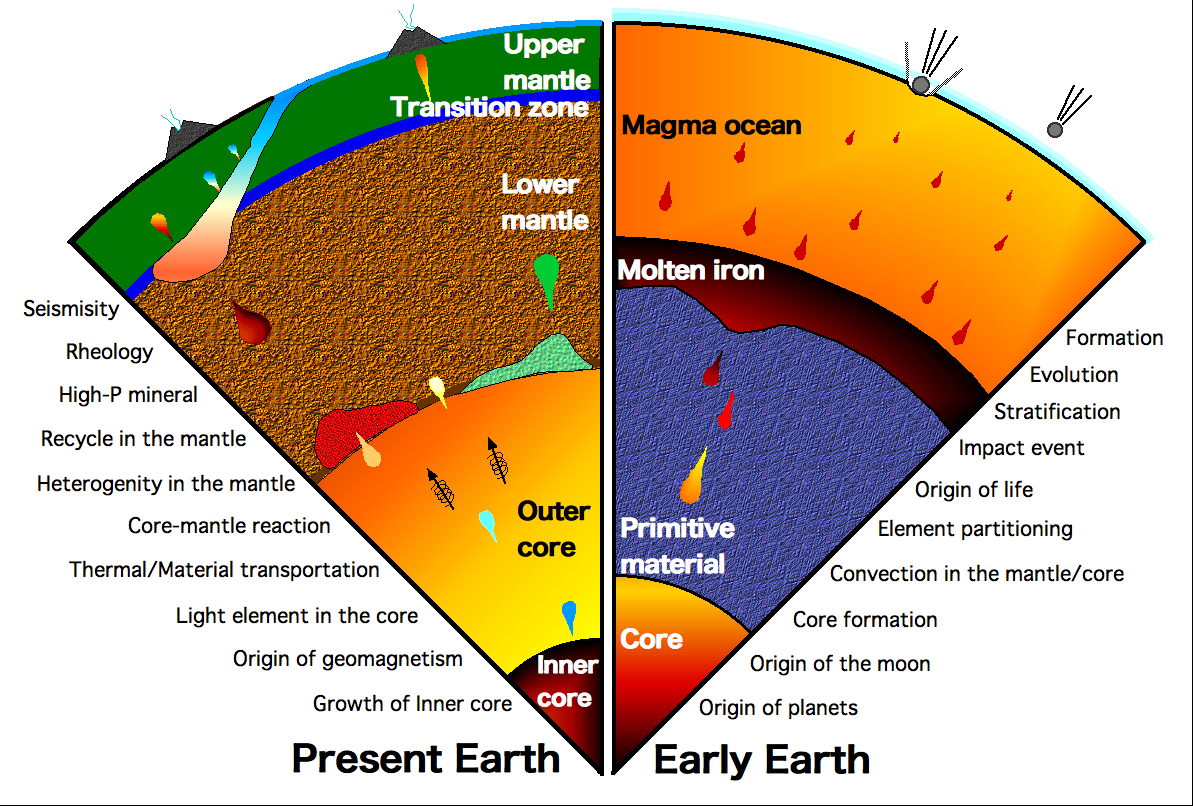
Our research interests are in the change of materials under extreme conditions of high pressure, high/low temperature, and strong magnetic field. Such conditions are generally realized in planetary interiors in nature. Most materials change their physical and chemical properties drastically in planets. For example, phase transition, crystal structure, density, elastic constants, electrical and magnetic properties, bonding nature, and chemical reaction with coexisting phases, are important clues for the geophysical modeling of planets. They affect the global structure, evolution and dynamics from the core to the surface. We generate extreme conditions in our laboratory by using various techniques of high-pressure generation (multi-anvil apparatus, laser-heated diamond anvil cell, laser shock), and then cook high-density materials and measure their property changes with various in-situ observation techniques of X-ray diffraction (synchrotron), imaging, spectroscopy, and electrical and magnetic measurements. Through these laboratory-based experiments, we strive for the comprehensive understanding of the planetary system and materials.
Infrared Astronomy Group (Sumi Group)
Members
-
Takahiro Sumi
-
Kento Masuda
-
Daisuke Suzuki
- Research area
-
We study astronomical phenomena by infrared observations (including visible light and submillimeter wavelengths) using ground-based telescopes and space telescopes, and develop instruments for such observations. In particular, we focus on understanding the formation process of exoplanets and aim to detect extrasolar biosignatures in the future. We are also conducting research on optical and near-infrared identification of gravitational wave sources (black holes and/or neutron star mergers), galaxy structure, and dark matter.
- Research topics, instruments and collaborations
-
1. MOA: More than 4,000 exoplanets have been discovered so far, but few of them are as small as the Earth outside the snow line, which is important for planet formation research. Therefore, we are using gravitational microlensing to search for such exoplanets. We are using MOA-II, a dedicated 1.8m wide-field telescope in New Zealand. We collaborate with Nagoya University, Auckland University, Massey University, Canterbury University, and NASA.
2. PRIME: A new wide-field telescope in the Republic of South Africa will be built to conduct microlensing planet survey in the near-infrared. The PRIME project is a collaboration with Astrobiology Center, Nagoya University, Massey University, SAAO, University of Maryland, JAXA, and NASA.
3. Roman: We participate in NASA's Roman mission scheduled for launch in 2025 to conduct microlensing planet survey from space. The goal is to reveal the distribution of all planets outside the Earth's orbit and to understand the process of planetary system formation. A joint research with JAXA, NAOJ, and NASA.
4. Searching for biosignatures: In preparation for NASA's proposed very large space telescope mission (OST, LUVOIR) in the 2030s, we are investigating and demonstrating technologies for the search for life outside the solar system. In collaboration with NASA, we are developing a highly stable instrument for use onboard satellites to measure the atmospheric composition of exoplanets and find traces of life (biosignatures) using direct imaging and transit spectroscopy method.
5. We study exoplanets, stars, and protoplanetary disks by using space and ground-based telescopes such as Kepler, TESS, Gaia, and ALMA. In particular, we aim to reveal the formation and evolutionary processes of various planetary systems through detailed studies of the orbital structures of transiting planetary systems.
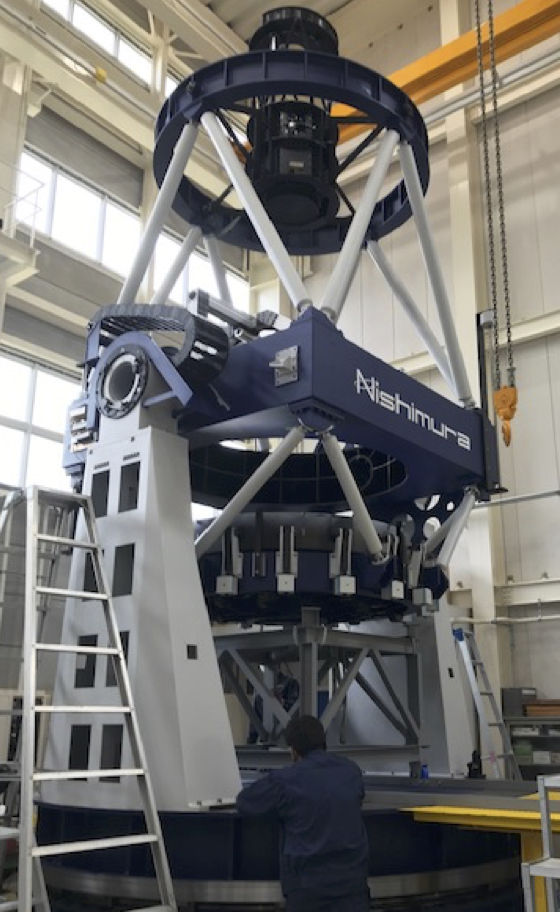
PRIME telescope
Theoretical Mineral Physics Group (Tsuchiya Group)
Members
Life and Planetary Evolution Science Group (Matsuo Group)
Members
-
Taro Matsuo
Soft Matter Earth and Planetary Science Group (Katsuragi Group)
Members
-
Hiroyuki Ebata
- Research area
-
Various complex phenomena occurring on the surface of the Earth and planetary bodies result from the complicated combinations of material behaviors such as fluidization, solidification, self organization. We are striving to reveal the fundamental processes governing these natural complex phenomena. Examples include, planetary surface terrain, origin of life, earthquake rupture dynamics. Development of the measurement techniques and experimental apparatus for various soft materials is also investigated in this group.
1)Physics of granular matter and its geophysical application
2)Biophysics
3)Material sciences of earthquakes and faults
4)Development of measurement method for soft matter characterization
5)Physics of fluids and multiphase systems and its application to nature
